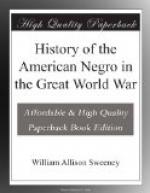When the Marbache sector was taken over by the 92nd Division, “No Man’s Land” was owned by the Germans and they were aggressively on the offensive. They held Belie Farm, Bois de Tete D’Or, Bois Frehaut, Voivrotte Farm, Voivrotte Woods, Bois Cheminot and Moulin Brook. Raids and the aggressiveness of the patrols of the 92nd Division changed the complexion of things speedily. They inflicted many casualties on the Germans and took many prisoners.
Each of the places named above was raided by the doughty black men as was also Epley, while their patrols penetrated north nearly to the east and west line through Pagny. The Germans were driven north beyond Frehaut and Voivrotte to Cheminot bridge. In their desperation they tried to check the Americans by an attempt to destroy the bridge over the Seille river. They succeeded in flooding a portion of the adjacent country; these tactics demonstrating that they could not withstand the Negro soldiers. West of the Seille river excellent results followed the energetic offensive, the Germans losing heavily in killed, wounded and prisoners. In nearly every instance the raids were conducted by Negro line officers.
Up to this time the division as a whole, had never been in a major battle. The only regiment in it that had seen a big engagement was the 368th infantry, which took part in the action in the Argonne Forest in September.
The division’s chance came in the great drive on Metz, just before the end of the war. They were notified at 4 o’clock Sunday morning, November 10th. The motto “See it through” of the 367th infantry, known as the “Buffaloes,” echoed through the whole division.
They began their advance at 7 o’clock from Pont a Mousson. Before them was a valley commanded by the heavy guns of Metz and by innumerable nests of German machine guns. The Negroes seemed to realize that here for the first time was the opportunity to show their mettle—that for the first time they were going to battle as a division. A sense of race pride seemed to stir and actuate every man. Here was a chance to show what this great body, composed of cotton-field Negroes, of stevedores, mechanics, general laborers, trades, professional men and those from all walks of civilian life who but recently had taken up the profession of arms, could do. An opportunity to enact a mighty role was upon them, and they played it well.
Not only were the black infantry and machine gun units up at the front; in the thickest of it, but the artillery—the 167th Brigade—was on the line behaving like veterans. They laid down a barrage for the infantry that was wonderfully effective. They established a reputation which has been made by but few, among French, British or Americans, of laying down a barrage that did not entrap; and fatally so, their own comrades.
It was a glorious day for the division. The casualty roll was heavy for the sector was strongly fortified and the enemy made a most determined resistance. Metz is considered by experts to be the strongest fortified inland city in the world.




